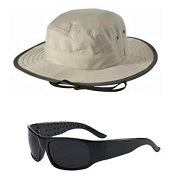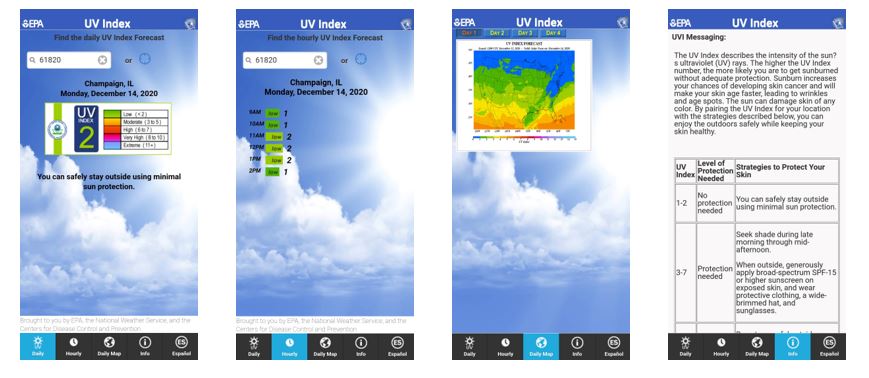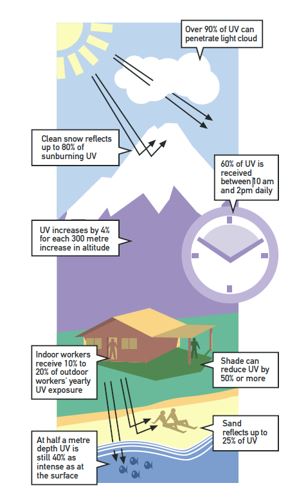Ultraviolet (UV) radiation emitted by the sun is known to cause skin cancer, skin aging, eye damage, and may affect the immune system. People who work outdoors are the most likely to experience short and long-term adverse health effects from UV radiation exposure. Workers who may be exposed to intense UV radiation levels must be aware of the risks and take the appropriate protective actions.
Health Risks of UV Radiation
Skin
- Sunburn and suntan are signs of short-term overexposure, while premature aging and skin cancer are side effects of prolonged UV exposure.
- Non-melanoma skin cancers (NMSCs) are basal cell carcinomas and squamous cell carcinomas that often appear as small, fleshy bumps or red, scaly patches. NMSCs typically form on sun-exposed areas of the body such as the head, face, neck, hands, and arms. Rarely fatal, but surgical treatment is required.
- Melanoma, the deadliest form of skin cancer, is usually caused by exposure to UV radiation. Presents as a new spot on the skin or an existing mole that looks abnormal or has changed over the past few weeks/months. It can occur anywhere on the body, so regular mole checks are recommended. A higher incidence is found in individuals with large numbers of moles and light-colored skin, hair, and eyes.
- Some oral and topical medicines, such as antibiotics, birth control pills, and benzoyl peroxide products, and some cosmetics, may increase skin and eye sensitivity to UV in all skin types. Check the label and ask your doctor for more information.
Eye
- Acute overexposure to UV radiation can cause photokeratitis and photoconjunctivitis. These inflammatory reactions, commonly known as snow blindness, are comparable to a sunburn of the eye. Symptoms include red eyes, a foreign body sensation or gritty feeling in the eyes, extreme sensitivity to light, and excessive tearing.
- Symptoms are usually temporary, rarely causing permanent damage to the eyes; however, chronic exposure to UV radiation contributes to macular degeneration of the retina and cortical cataracts, both a cause of blindness.
UV Radiation Exposure Protection
Engineering controls
- Outdoor workers should have access to shade cover or canopies.
Administrative controls
- Schedule work outside of peak UV radiation periods (2 hours either side of solar noon).
- Provide frequent breaks in the shade or under a canopy.
Personal protective equipment (PPE)
- Wear clothes that cover your arms and legs.
- Dark colors generally provide more protection than light colors.
- Loose-fitting, tightly woven fabric protects better than tight-fitting, loosely woven clothing.
- Dry fabric is generally more protective than wet fabric.
- Sun-protective clothing that has special coating to absorb UV rays is also available.
- Wear a wide brim hat to shade your face, head, ears and neck.
- Wear wraparound sunglasses that block both UVA and UVB rays to protect your eyes and the skin around them.
- Use sunscreen with sun protection factor SPF 30 or higher for both UVA and UVB protection. Use lip balm containing sunscreen.
- Pay close attention to your face, ears, neck, arms, and any other areas not covered by clothing.
- If you're going to wear insect repellent, put the sunscreen on first.
- Sunscreen should be reapplied at least every 2 hours to maintain protection and more often when you sweat. Water-resistant sunscreens must state whether they protect the skin for 40 or 80 minutes of sweating, based on testing.
- Although some makeup may contain SPF 15 or higher, be sure to apply a layer of sunscreen underneath.

Ultraviolet Index (UVI)
The UV Index is a rating scale, with numbers from 1 to 11, which indicates the amount of skin-damaging UV rays reaching the Earth’s surface during the day.
Exposure Category | UVI Range | Strategies to Protect Your Skin / Effects |
Low | 1 – 2 | Low danger.
|
Moderate | 3 – 5 | Moderate risk of harm. Take precautions.
|
High | 6 – 7 | High risk of harm. Protection needed.
|
Very High | 8 – 10 | Very high risk of harm. Protection needed.
|
Extreme | 11+ | Extreme risk of harm. Avoid sun exposure during midday hours, from 10 am to 4 pm. Liberally apply sunscreen with an SPF-30 or greater every 2 hours.
|
EPA’s SunWise UV Index App
Download the EPA’s SunWise UV Index6 app available for Android and iPhone devices. This useful app predicts the ultraviolet radiation levels on a 1-11+ scale for your location and appropriate precautions. Use the hourly index to plan your outdoor activities accordingly.


The strength of UV rays reaching the ground depends on several factors, such as:
- Time of day: UV rays are strongest between 10 am and 4 pm.
- Seasons: UV rays are stronger during the spring and summer months; this is less of a factor near the equator.
- Clouds: UV radiation levels are highest under cloudless skies, but UV radiation levels can be high even with cloud cover.
- Surface reflection: UV rays can bounce off surfaces like water, sand, snow, pavement, or even grass, leading to increased UV exposure.
- Latitude: UV exposure goes down with increased distance from the equator.
- Altitude: More UV rays reach the ground at higher elevations.
- Contents of the air: Ozone in the upper atmosphere, for example, filters out some UV radiation. Ozone levels vary over the year and even across the day.

Pro Tip - The Shadow Rule
An easy way to tell how much UV exposure you are getting is to look for your shadow:
- If your shadow is taller than you are (in the early mornings and late afternoon), your UV exposure is likely to be lower.
- If your shadow is shorter than you are (around midday), you are being exposed to higher levels of UV radiation.
Resources
- American Cancer Society - UV Radiation: https://www.cancer.org/cancer/cancer-causes/radiation-exposure/uv-radiation.html
- American Cancer Society – UV Protection: https://www.cancer.org/healthy/be-safe-in-sun/uv-protection.html#
- CDC – UV Radiation: https://www.cdc.gov/nceh/features/uv-radiation-safety/index.html
- CDC – Sun Safety: https://www.cdc.gov/cancer/skin/basic_info/sun-safety.htm
- EPA – Sun Safety: https://www.epa.gov/sunsafety
- EPA – UV Index Mobile App: https://www.epa.gov/enviro/uv-index-mobile-app
- EPA – UV Index Scale: https://www.epa.gov/sunsafety/uv-index-scale-0
- National Comprehensive Cancer Network – Melanoma: https://www.nccn.org/patients/guidelines/content/PDF/melanoma-patient.pdf
- National Weather Service: https://www.weather.gov/ilx/uv-index
- WHO: https://www.who.int/uv/publications/en/UVIGuide.pdf